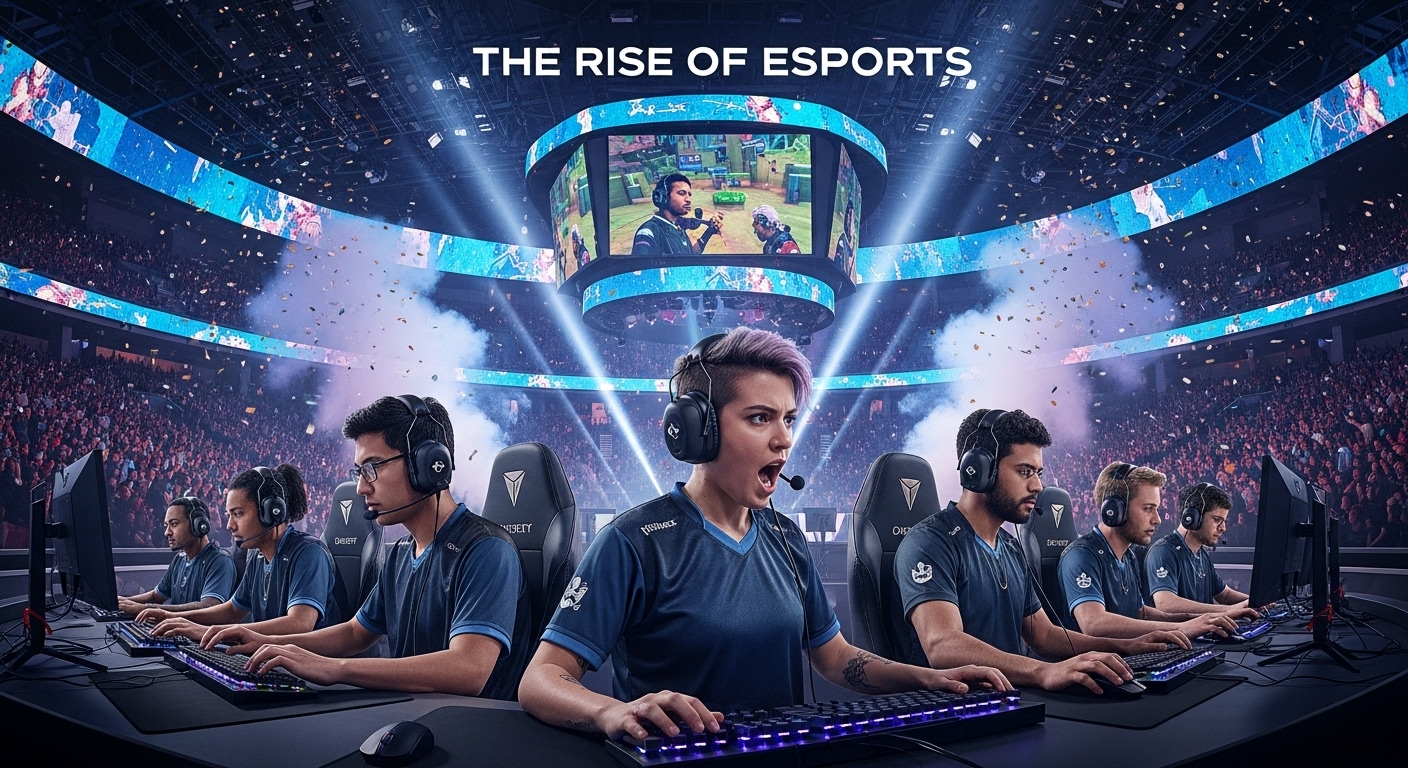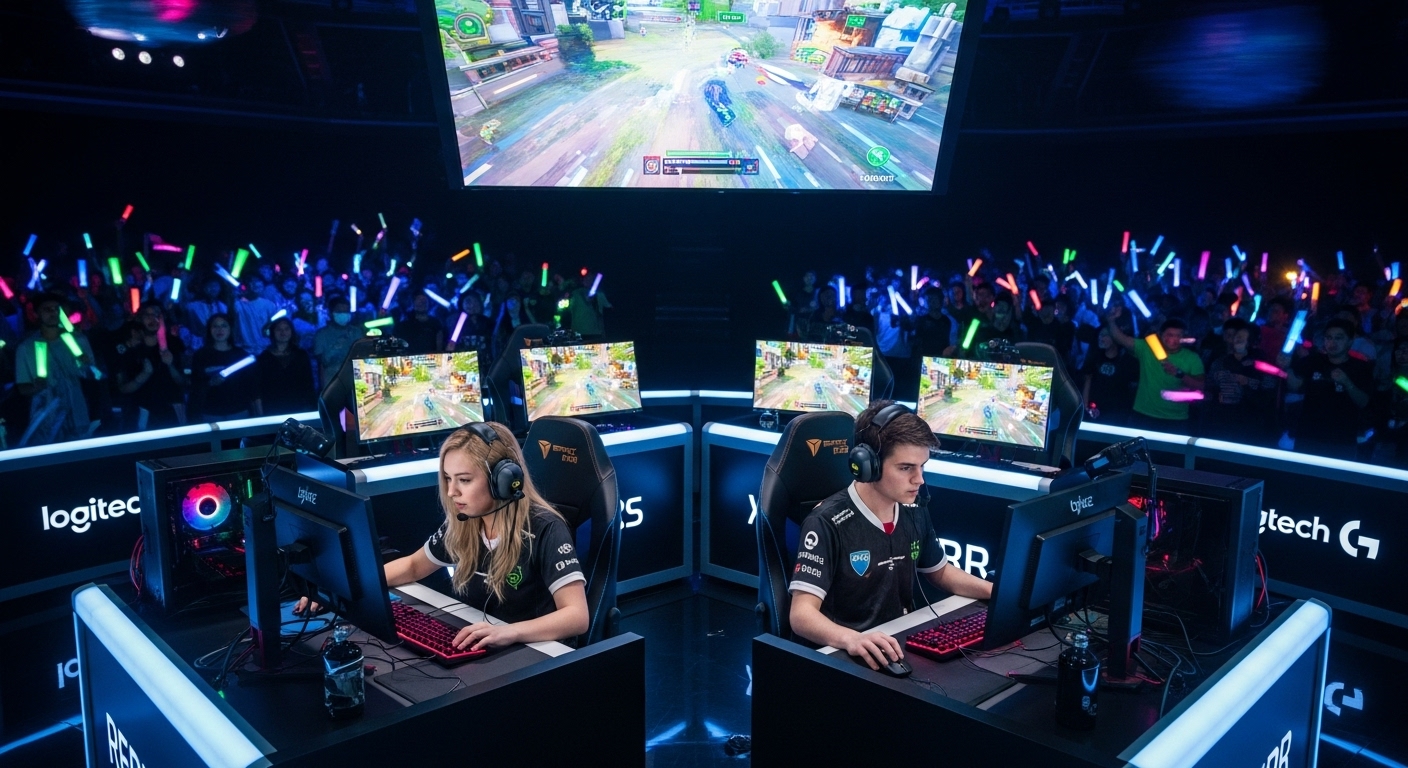Introduction: The Digital Revolution of Competition
Over the last few decades, humanity has witnessed the birth of an entirely new form of sport—one that doesn’t depend on physical arenas, grassy fields, or traditional athleticism. Instead, it thrives in virtual worlds where pixels become playing fields and reflexes, strategy, and teamwork reign supreme. This phenomenon is known as Esports, short for electronic sports. What began as small gatherings of gaming enthusiasts has transformed into a global industry worth billions, drawing millions of viewers and professional players who train as rigorously as any traditional athlete. Esports is no longer a niche hobby—it is a cultural and economic powerhouse shaping entertainment, technology, and even education in the 21st century.
The Early Days: When Gaming Became Competitive
The roots of Esports stretch back farther than many realize. In the 1970s and 1980s, the first competitive video gaming events took shape around titles such as Space Invaders, Pac-Man, and Donkey Kong. These contests were often held in arcades or small university halls, where gamers competed for high scores and bragging rights. The Space Invaders Championship in 1980, organized by Atari, drew around 10,000 participants in the United States, marking one of the first large-scale gaming competitions. Though primitive by modern standards, this event laid the groundwork for a movement that would evolve alongside gaming technology.
As computers and consoles improved during the 1990s, so too did the competitive scene. Games like Street Fighter II, Quake, and StarCraft turned casual players into dedicated competitors. The birth of the internet made it easier for players to connect, share strategies, and compete remotely. South Korea emerged as a pioneer in organized Esports during this period, with the government investing in broadband infrastructure and nurturing a gaming culture that would eventually produce some of the world’s first professional gamers.
The 2000s: Esports Finds Its Footing
The new millennium brought a surge in global connectivity and accessibility. Broadband internet became commonplace, online gaming platforms grew rapidly, and streaming began to emerge as a new way to share gameplay with audiences. Tournaments became more organized, prize pools grew larger, and sponsorships began to flow in. Games like Counter-Strike, Warcraft III, and Halo became synonymous with early competitive gaming.
In South Korea, StarCraft: Brood War dominated television screens as professional leagues were established and players like Lim “BoxeR” Yo Hwan became household names. Esports in Korea wasn’t just a pastime—it was a respected profession, with players living in team houses, receiving coaching, and participating in media appearances. This professionalization inspired other regions to take Esports seriously.
Meanwhile, in the West, organizations such as Major League Gaming (MLG) began organizing professional tournaments for console and PC gamers. MLG events attracted thousands of participants and even more viewers online. Esports was no longer an underground culture—it was gaining mainstream attention and respect.
The Streaming Revolution and Global Explosion
The 2010s marked a defining decade for Esports. The launch of streaming platforms, particularly Twitch in 2011, revolutionized how audiences consumed gaming content. Instead of waiting for televised broadcasts, fans could now tune in to live streams from anywhere in the world, watch their favorite players in real time, and interact directly through chat. This accessibility bridged the gap between professional players and audiences, fostering a community-driven entertainment model that traditional sports could only envy.
Titles like League of Legends, Dota 2, and Counter-Strike: Global Offensive became international staples of competitive gaming. League of Legends established the League Championship Series (LCS) and regional leagues across the globe, culminating in the annual World Championship that attracted millions of viewers. Dota 2’s tournament, The International, shattered records with its crowd-funded prize pools, sometimes exceeding tens of millions of dollars. These events transformed Esports from a subculture into a legitimate global industry, complete with sponsors, media coverage, and professional organizations.
The Rise of Esports Organizations and Professionalism
As Esports gained momentum, the need for structure and management became evident. Teams began operating like traditional sports franchises, with dedicated management, coaches, analysts, and support staff. Organizations such as Fnatic, Team Liquid, Cloud9, and T1 built brands that rivaled conventional sports clubs in influence and recognition. Players were signed to contracts, given salaries, and treated as professional athletes.
This era also saw the rise of team houses and training facilities where players could practice together under supervised conditions. Nutritionists, psychologists, and performance coaches joined the industry to ensure players could handle the physical and mental demands of high-level play. The narrative that “gamers are lazy” started to crumble as the public began to see the dedication and discipline required to compete professionally.
With professionalism came business growth. Sponsors from non-endemic industries—automotive, apparel, energy drinks, and even financial institutions—started investing in Esports. Companies recognized that Esports audiences were young, tech-savvy, and highly engaged, offering a valuable demographic for advertising and brand building.
Esports as Spectacle: The Stadium Era
Esports’ transformation into a spectator sport reached its peak when live tournaments began filling massive arenas traditionally reserved for concerts and traditional sports events. Venues like Madison Square Garden, Staples Center, and the Bird’s Nest in Beijing have hosted Esports finals that attracted tens of thousands of live spectators and millions of online viewers.
The production value of Esports broadcasts also skyrocketed. Modern Esports events rival Hollywood productions, complete with professional commentators, augmented reality stage designs, and intricate storylines surrounding players and teams. The pageantry and emotion of watching top-tier competition unfold in real time became one of Esports’ greatest strengths. For many fans, cheering for a favorite team or player evokes the same passion and loyalty as supporting a football club or basketball franchise.
The Diverse Landscape of Competitive Games
Esports is not a single monolithic entity—it’s a collection of competitive ecosystems centered around various genres and titles. Each game develops its own community, culture, and competitive structure.
MOBA (Multiplayer Online Battle Arena) Games: Titles like League of Legends and Dota 2 dominate this category. These games emphasize strategy, teamwork, and real-time decision-making. Teams of five compete in intense matches that can last from twenty minutes to over an hour, requiring coordination and precise execution.
FPS (First-Person Shooter) Games: Counter-Strike: Global Offensive, Valorant, and Call of Duty represent this genre, where reflexes, communication, and tactical play are key. FPS games often attract fast-paced, adrenaline-driven fans who love the intensity of close combat.
Battle Royale Games: Fortnite and PUBG have created their own Esports niches, blending massive player counts with survival elements and unpredictable gameplay. Fortnite’s World Cup in 2019 offered a $30 million prize pool, cementing its place in competitive gaming history.
Sports and Racing Games: Titles like FIFA, NBA 2K, and Rocket League provide a bridge between traditional sports fans and gaming enthusiasts. These games replicate real-world sports with a digital twist, often attracting crossover audiences.
Fighting Games: The fighting game community, or FGC, remains one of the oldest and most passionate Esports scenes. Games such as Street Fighter, Tekken, and Super Smash Bros. have maintained loyal competitive followings for decades, emphasizing skill, timing, and deep mechanical mastery.
The Impact of Technology on Esports Growth
Esports owes much of its evolution to technological progress. High-speed internet, powerful gaming hardware, and advanced software have all played pivotal roles in making global competition possible. Improved streaming quality and lower latency connections have turned online play into a viable professional platform. Virtual reality and augmented reality are beginning to offer new frontiers for competitive gaming, while artificial intelligence is being used to analyze gameplay and enhance training.
Cloud gaming services have the potential to make Esports even more accessible, removing the barrier of expensive gaming PCs and allowing anyone with a stable internet connection to compete. Additionally, advancements in data analytics allow teams to dissect their performance in detail, identifying weaknesses and optimizing strategies with unprecedented precision.
Esports and Education: The Classroom Meets the Arena
One of the most fascinating developments in recent years is the integration of Esports into education. Universities around the world have begun offering scholarships to talented players, recognizing the discipline, communication, and problem-solving skills that competitive gaming cultivates. High schools and colleges are forming Esports teams, building arenas, and even developing academic programs that explore the business, psychology, and technology behind the industry.
This academic embrace of Esports has helped dispel stereotypes and fostered inclusivity. It has also opened new career pathways—not only for players but for coaches, event organizers, marketers, and game developers. The Esports ecosystem offers opportunities across numerous disciplines, making it an appealing option for young people passionate about gaming and technology.
Esports and Traditional Sports: A Symbiotic Relationship
While Esports and traditional sports might appear to be competitors, in reality, they share many parallels and have increasingly collaborated. Traditional sports franchises have invested in Esports organizations, with NBA, NFL, and European football teams purchasing or sponsoring gaming teams.
The crossover appeal is mutual. Traditional sports bring institutional experience, brand recognition, and funding, while Esports introduces younger audiences and digital engagement. Major events like the Olympics have even begun to explore the inclusion of Esports-related competitions, signaling recognition from the highest levels of athletic governance.
The Globalization of Esports
One of Esports’ defining characteristics is its global reach. Unlike many traditional sports that are regionally dominant, Esports transcends borders and languages. A player from Brazil can compete against one from Sweden, a team from South Korea can face off with a squad from North America, and fans from every corner of the world can tune in simultaneously.
This interconnectedness has fostered cultural exchange and community. Fans celebrate diversity and collaboration in a way that reflects the borderless nature of the internet. The globalization of Esports has also created opportunities for developing nations to participate on an equal footing, using technology as the great equalizer.
Challenges and Controversies in Esports
Despite its success, Esports faces several challenges. Player burnout is a significant issue, as the rigorous schedules and intense pressure can take a toll on mental health. The average professional career span in many Esports titles is short, often less than five years. Issues such as unfair working conditions, lack of regulation, and inconsistent player protections have also been debated.
Another major concern is cheating and match-fixing. As prize pools grow, the temptation for unethical behavior increases. Anti-cheat technologies and integrity enforcement agencies have been established, but maintaining fair play remains an ongoing battle.
Toxicity in online communities is another issue that the industry continues to confront. Developers, leagues, and influencers are working to promote inclusivity, respect, and positive gaming environments, but cultural change takes time and persistent effort.
The Role of Women and Diversity in Esports
Historically, Esports has been a male-dominated industry, but this is changing. More women are competing professionally, streaming, and leading organizations. Female-focused tournaments and initiatives are providing visibility and opportunity for women in gaming, while conversations around inclusivity are reshaping community standards.
Diversity extends beyond gender—it includes representation across ethnicity, culture, and ability. As Esports continues to globalize, embracing this diversity is essential to ensuring the industry’s long-term health and authenticity. The more inclusive Esports becomes, the stronger and more sustainable it will be as a cultural movement.
The Future of Esports: What Lies Ahead
Esports is still young compared to traditional sports, yet its trajectory suggests a future of immense growth and innovation. Virtual reality could introduce entirely new types of competitions where physical movement and digital gameplay blend seamlessly. Blockchain technology may revolutionize ownership, tournament management, and fan engagement through transparent digital economies.
Franchising models, similar to traditional sports leagues, are becoming more common, providing stability for teams and investors. Governments are also beginning to recognize Esports officially, offering visas for professional players and hosting national leagues.
As media and entertainment continue to evolve, Esports will likely integrate further into mainstream culture. It will not only be a form of entertainment but also a cornerstone of digital identity, shaping how future generations understand competition, teamwork, and creativity.
Conclusion: Beyond the Screen
Esports represents more than just competitive gaming—it symbolizes the evolution of how humans engage with technology, entertainment, and each other. It’s a reflection of a connected world where talent and passion can transcend physical and cultural boundaries. From humble arcade beginnings to sold-out arenas, Esports has redefined what it means to be an athlete, a fan, and a participant in the global digital age.
As the line between physical and digital experiences continues to blur, Esports stands as one of the defining cultural movements of our time. It is not a passing trend but a foundational part of modern entertainment and communication. Whether one is a player, a viewer, or simply an admirer of innovation, the story of Esports is a testament to how creativity, competition, and community can shape the future.



